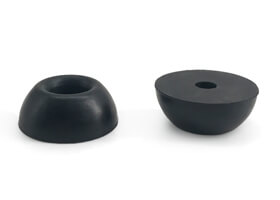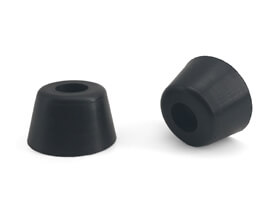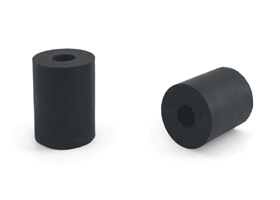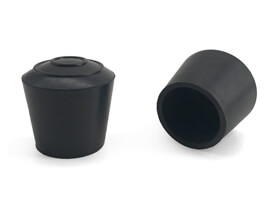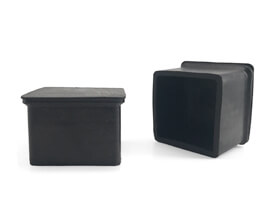PROFESSIONAL RUBBER BUMPER AND RUBBER FEET MANUFACTURER
We are rubber silicone products manufacturer. With more than 20 years’ experience, producing over 18,000+ kinds of rubber products for our customers. Custom Bumper available! For any special shaped products, fastest 48 hours can be achieved from design prototype to production samples.
Our Products
REQUEST A QUOTE
Need any quotation?
Cannot found your size?
Customized service needed?
ETOL can recommend the most suitable products for you according to your requirements. We ensure the consistent quality, best price, and on-time delivery. Contact us for more information!
What is a Rubber Feet and a Rubber Bumper?
Rubber feet and rubber bumpers are widely used. If you take a look at the appliances that make your everyday easier, you will spot numerous occasions where rubber bumpers are present. Rubber feet are small parts manufactured from natural or synthetic rubber and they are usually attached to the bottom of slippery objects. Their application aims to protect the furniture, ladders, and chair legs. Moreover, their soft material ensures that the floor will not be scratched as they improve the grip of the furniture. For this reason, colleges, universities, schools, and businesses in the hospitality industry use them.
On the other hand, rubber bumpers have a wider variety of applications both in the interior and the exterior of various devices. Rubber bumpers are small parts that you can find in multiple sizes and shapes. The main goal for their manufacture is that they are perfect to absorb the shock between two objects. Furthermore, they can minimize the potential damage from a collision. These attributes have found for them many applications in vehicles and other devices, like mixing consoles. Rubber bumpers are also normally used as stoppers and spacers.
In general, the many advantages of rubber feet and rubber bumpers are the following:
- Protection of the equipment from scratches: These small rubber feet are very effective in the protection of the equipment’s edges. With everyday use, all the appliances obtain scratches that make them look old. With the application of rubber appliance feet, though, every device retains a sharp look, with edges like new.
- Shock and impact absorption: If the first advantage was all about the way an appliance looks, the second one is about its smooth function. Vehicles, speakers, and home appliances create movement and vibrations. Rubber bumpers are placed carefully inside the machine so that the shock is absorbed. This way, the internal parts of the device are protected from one another, thus making the device last longer.
- No marks on the floor: Chairs, ladders, and pieces of furniture like these, often leave marks and scratches on the floor. The only way to prevent them is to enhance the furniture with rubber feet.
- Prevention of slippage: A common use of both of these parts is to prevent slippage. Some surfaces, like pre-engineered wooden floors, are exceptionally slippery. Moreover, in some cases, the devices are stacked on top of each other, such as in the case of speakers. The vibrations created by their operation can slightly move the appliances on top. Thus, by placing rubber bumper pad between them, the risk of falling down is significantly reduced.
- Reduction of sound: When a chair is dragged on the floor, the sound can be rather loud and annoying. However, if the chair has rubber tips the sound isn’t deafening. This is extremely important where a quiet environment is crucial, namely in a classroom.
- Proper spacing and ventilation: Heat can destroy the appliances in the long term. For this reason, many use rubber bumpers to separate the devices and let them breathe. Proper ventilation is the only way to ensure the proper function of the appliances for many years.
- Easy customization: The great thing about these parts is that they are easily customizable. Whether you need a specific size or color, whether you need a specific size or color, you can contact us for customized service.
The Applications of Rubber Feet
As you can see, rubber bumpers have many applications. The most notable of them are the following:
- On vehicles: Rubber bumpers are used in many parts of a vehicle. First of all, they can be applied outside of a car to prevent scratched and other light damages. Moreover, you will find them in a vehicle’s cooling system, its doors, the glove box, and the license plate, to name a few. The bumpers used on vehicles are heave and corrosion-resistant.
- In the office: Self-adhesive rubber feet are also present in every piece of equipment in an office. Chairs and cabinet doors are enhanced with them so that they don’t make noises. Moreover, these parts are present underneath telephones, keyboards, coasters, and other things in the office, offering them stability. Additionally to this, computers and laptops have silicone bumpers underneath so that they don’t overheat.
- In the kitchen: Rubber bumpers can also come in handy at home. In the kitchen, you can use them in the cabinets and the drawers to reduce the sound. Moreover, you can place them underneath various kitchen appliances so that they don’t slip. Indicatively, the coffee maker, blender, and mixer will benefit from rubber bumper stopper.
- On audiovisual equipment: The audiovisual equipment needs to remain steady. Anything that cases slightly movement to the cameras and mics can cause disturbances in the final footage. For this reason, many audiovisual professionals enhance their tripods and stands with high-quality heavy duty rubber feet. Furthermore, parts like these are used in the robotics industry, for the same reason.
- On tables: If you have a glass table, then you already know that it needs extra care to remain intact. In many cases, people attack rubber bumpers on the edges of the glass to protect it. Apart from this, they also place clear glass table top bumper between the wooden table and the glass to prevent slippage.
- As door stoppers: A common use for rubber door bumpers is as door stoppers. If you are not careful, you might damage the walls with the doorknob. Even if you are not using force, time will eventually wear the wall at this part.
- At the back of picture frames: Another use for small rubber bumpers is to keep picture frames and mirrors steady. By placing some bumpers at the back of the picture frame, you can keep them level, thus also protecting the walls.
What is their Usage Method?
There are many types of rubber feet and bumpers on the market. Most of the appliances already have some attached to make them easier to use. However, the parts underneath the devices you use every day might need to change after some time as they tend to get worn. If this is the case, then you can easily purchase some new adhesive rubber bumpers and apply them wherever you need them. The application is an easy process. To do that, follow the steps you will find below:
Step 1: Clean the surface you are going to attach the rubber bumper. If you notice that there are excess oil and dirt on the surface, you can use some isopropyl alcohol to rub it off. In any case, make sure that the surface is completely clean and dry before you apply the bumper.
Step 2: Remove the bumper from its sheet, making sure that you don’t touch the adhesive glue.
Step 3: Place the rubber feet pad where you need them and press them to stick to the surface. For example, if you want to apply them at the back of a picture frame, the best place for them is at the two bottom corners of the frame. However, make sure that you avoid putting the bumper under pressure and weight for up to 24 hours. If you let it sit for a while, the adhesive will cure and you will enjoy a long-lasting result.
Moreover, you might need to replace or attach rubber feet to a chair. For this, you will need to measure the diameter of the chair’s leg. Once you know the correct size and shape, you can purchase the appropriate rubber furniture bumper. The application of them to the chair is easy, as you only need to apply some pressure.
Available Shapes and Types of Rubber Bumpers
To get the right proper rubber bumper and rubber feet for your needs, you have to know the specifications. The available shapes for these parts are cylindrical, oval, square, rectangular, and hemispherical. Furthermore, you can find some bumpers in more complex shapes, like hexagonal and roll stock. Rolls are ideal for the application of bumpers on cars.
On the other hand, the available types of rubber parts are the following:
- Cylinder bumpers: These are cylindrical and find many applications. Namely, they can be used as rubber feet for chairs.
- Grommet style: These round rubber bumpers can be inserted into a pre-existing hole. They are easy to apply and they protect from abrasion, noise, and vibration.
- Machine screw: These bumpers have screws that are then attached to the surface. They are strong and for this, they are ideal for feet to chairs and machinery.
- Plug style: Plug bumpers are often used to close holes. They can easily be plugged into a pre-drilled hole.
- Recess style: These heavy bumpers offer maximum protection from abrasion, vibration, and compression. They cushion the parts that need protection and for this, they have found many applications in the manufacturing industry.
- Self-adhesive: This type of bumper is the most common you will find and use. They can easily be applied to any surface you need them.
- Stem style: These soft rubber bumper also require a pre-drilled hole for their application. They are often placed underneath small cabinets and other small pieces of furniture to keep them from slipping.
Material Classification Used for Rubber Feet
The material used for the manufacturing of the rubber feet is its most important specification. The material must have elastic properties and hardness. The following materials are widely used for their manufacturing:
- EPDM: Ethylene-propylene, or EPDM, has great weather, chemical, and heat resistant. Because it can be used in any condition, rubber bumpers of this material are applied to water pumps, car breaks, and other industrial uses.
- Natural Rubber: This material comes from the latex of the rubber tree. It is known for its surface friction properties, as well as its great resistance to abrasion. A common use for natural rubber is for vibration isolators.
- Neoprene: This material is considered a general use elastomer, as it finds many applications. It has excellent resistance to ozone, UV, petroleum oils, and Freon and ammonia. Its uses include rubber bumpers placed in refrigerators and general-purpose seals.
- Nitrile: This specific material dominated the seal industry, as it has high resistance to petroleum oils and exceptional tear and abrasion resistance. Bumpers manufactured by Nitrile are often used on vehicles and for industrial purposes.
- Silicone: This is probably the most flexible material used for the manufacturing of silicone bumpers. Moreover, it is resistant to extreme temperatures and compression. Silicone is a semi-organic and clean material and for this, it has found wide applications in the food and medical industries.
- SBR: Styrene-Butadiene, or SBR, is great for plumbing applications because it has excellent resistance to water and other fluids.
- Viton: This material is great for its resistance to chemicals, heat, and compression. Bumpers made from Viton are used in seals and engines.
The Manufacturing Process Explained
For the elastomers to be converted to useful products, like rubber feet, manufacturers follow a procedure called rubber molding. In this process, the uncured elastomer is processed with chemicals that toughen and harden its polymer chain. However, there are multiple methods in which rubber molding is performed.
First of all, in the rubber compression process, the uncured elastomer is placed in a mold that compresses it into the desired shape. When the mold is closed, the material is cured with the help of heat. Once the shape is finalized, the product is removed from the mold and the manufacturer removes the excess rubber.
The second method is that of rubber injection molding. For this, the elastomer becomes liquid, before it is injected in a mold. When the product is complete, it is removed from the mold.
Lastly, there is the rubber transfer molding. For this process, the rubber is placed in a pot and later enters the mold through an aperture. After the process is complete, the manufacturer removes the product by breaking the mold.
Rubber bumpers are widely used in our everyday lives. Taking into consideration all of the above specifications, you can choose the ones that best suit your needs for long-lasting results.
Why Choose Us
Plentiful Experience
With over 20 years’ experience on rubber and silicone industrial, we manufacturing products for over 5000+ customers in 60+ countries. ETOL aims to solve any difficult and special problems according to your requirements.
High Quality Products
Certificated by ISO9001, FDA, RoHS etc. All the products are compliance with RoSH standard. Over 5,000 customers from 60+ countries have a long-term cooperation with us.
Fast Delivery
Once you place an order, we will send it out as soon as possible. 3 Days fastest you will receive the products.
Great Variety of Products
Over 18,000+ kinds of products available, No need any mold cost, you can found the one you need directly!
Free Samples
Worry about the size and quality? Contact us to get free samples! You only need to pay the shipment, and we will send it to you for testing.
Custom service
From design, prototyping, mold making, mass production and delivery, we offer the one-stop complete process for you.
REQUEST A QUOTE
Need any quotation?
Cannot found your size?
Customized service needed?
ETOL can recommend the most suitable products for you according to your requirements. We ensure the consistent quality, best price, and on-time delivery. Contact us for more information!
